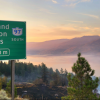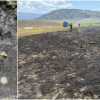It was the solstice with the mostest.

Just shy of 100 people hiked to the multi-stone array called Penhenge at the top of Munson Mountain Thursday afternoon to celebrate the winter solstice and the shortest day of the year.

The crowd was, according to several longtime attendees and two of the people who were instrumental in conceiving and transporting Penhenge to Munson way back in 2010, the largest winter solstice turnout to date.

It certainly thumped last year's number, impacted by an official temperature of -17 and wicked winds that made it feel much colder than that. Indeed, given the COVID social restrictions of 2020 and 2021, it's been awhile since more than a dozen people observed the Dec. 21 sunset.

On hand and once again playing the role of solstice maestro as he seems he was born to do was retired Dominion Radio Astrophysical Observatory scientist and Penhenge driving force Chris Purton.

Purton, clearly buoyed by the attendance, entertained and educated the crowd with even more gusto than usual. Did it matter that a thick cloud cover obscured the all-important sunset? With a guy like Purton running the show, assisted by friend and associate Ryan Ransom and that big upbeat crowd, not so much.

The key takeaway from this and every other winter solstice celebration? From here on out, right up 'til the summer solstice on June 21, the darkness shrinks and the number of daylight minutes increase.

Amongst the crowd Thursday was Peachland resident and astronomy club member Mark Force, who was busy chatting with friends and pointing to various spots on the horizon when we interrupted.

"This is a just a great event to get out and see fellow astronomers and meet other people with similar interests," he said. "Plus, it's a great view. And it’s not snowy or rainy."

Force attended the ridiculously frigid event last December and has observed Munson summer solstices too.
"I think the biggest thing here is the effort people put in to make this monument to celestial mechanics," he said about Penhege, which effectively points the way to the sunset points during both solstices and both equinoxes.

"It's all about the rotation of the earth and the cycles of the stars. Now the days start getting longer."
Bringing chairs to the top were mom Rebecca Nanning and kids Claire and Sam.

It was their first time at a solstice and it seemed like they were having fun.
"We read about it and thought it would be fun to celebrate," said Nanning. "It’s a neat alternative to Christmas. It seems like a good way to feel the refresh of the year."

Derek Evans was in the middle of a group of people who seemed to know him pretty well.

"I've studied some astronomy," he said. "I got turned on to astronomy about 20 years ago by Chris Purton. I used to be the director of the Naramata centre and he would come and give classes there."
For Ryan Ransom, an Okanagan College professor of physics and astronomy and a member of the Royal Astronomical Society, the solstice-y trip to the peak of Munson is nothing new.

He was part of the team, headed by Purton, that installed the Penhenge stone array in 2010. And on this day, as he's done before, he acted as MC.
"You know, the first year of Penhenge, 2010, was like this. Cloudy. But 2011 was spectacular. My daughter was, I think, seven years old and standing on the winter solstice stone with her snowsuit and toque and pompom in the sunset.

"Others have helped as well, but it was Chris seeing it through, testing it year after year until we were sure where we wanted to put the stones.
"So watching the sun create that spark at the moment of sunset on my daughter's pompom was the moment we knew this was very much worth the effort."

















